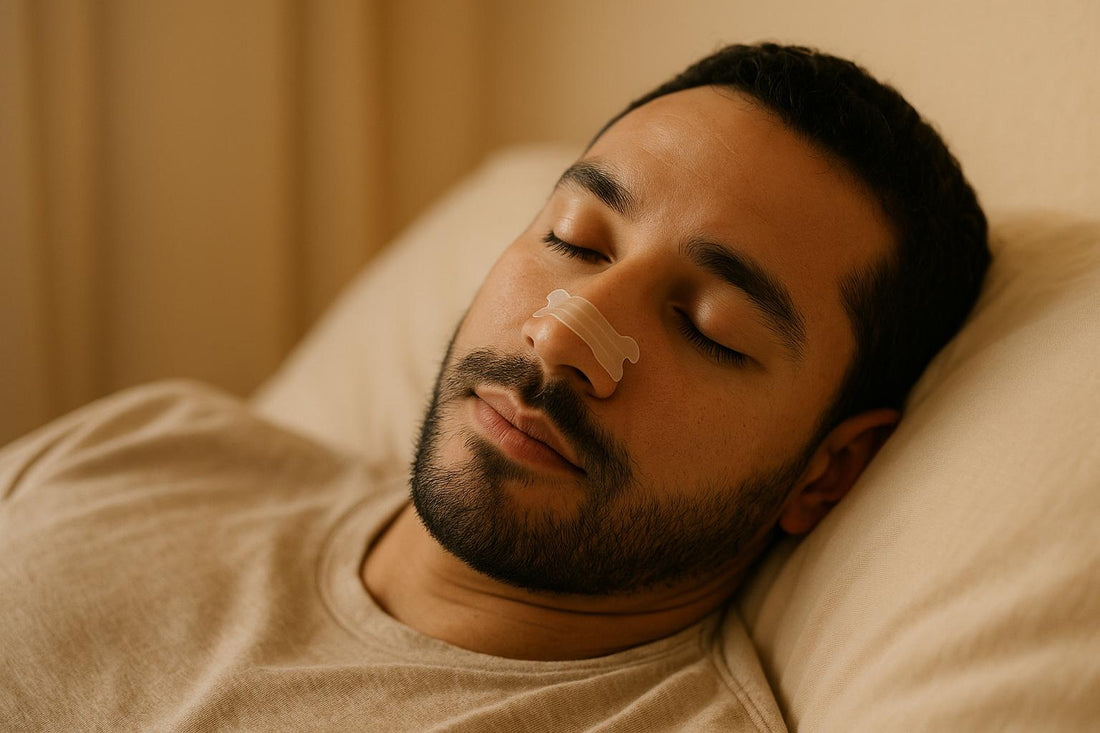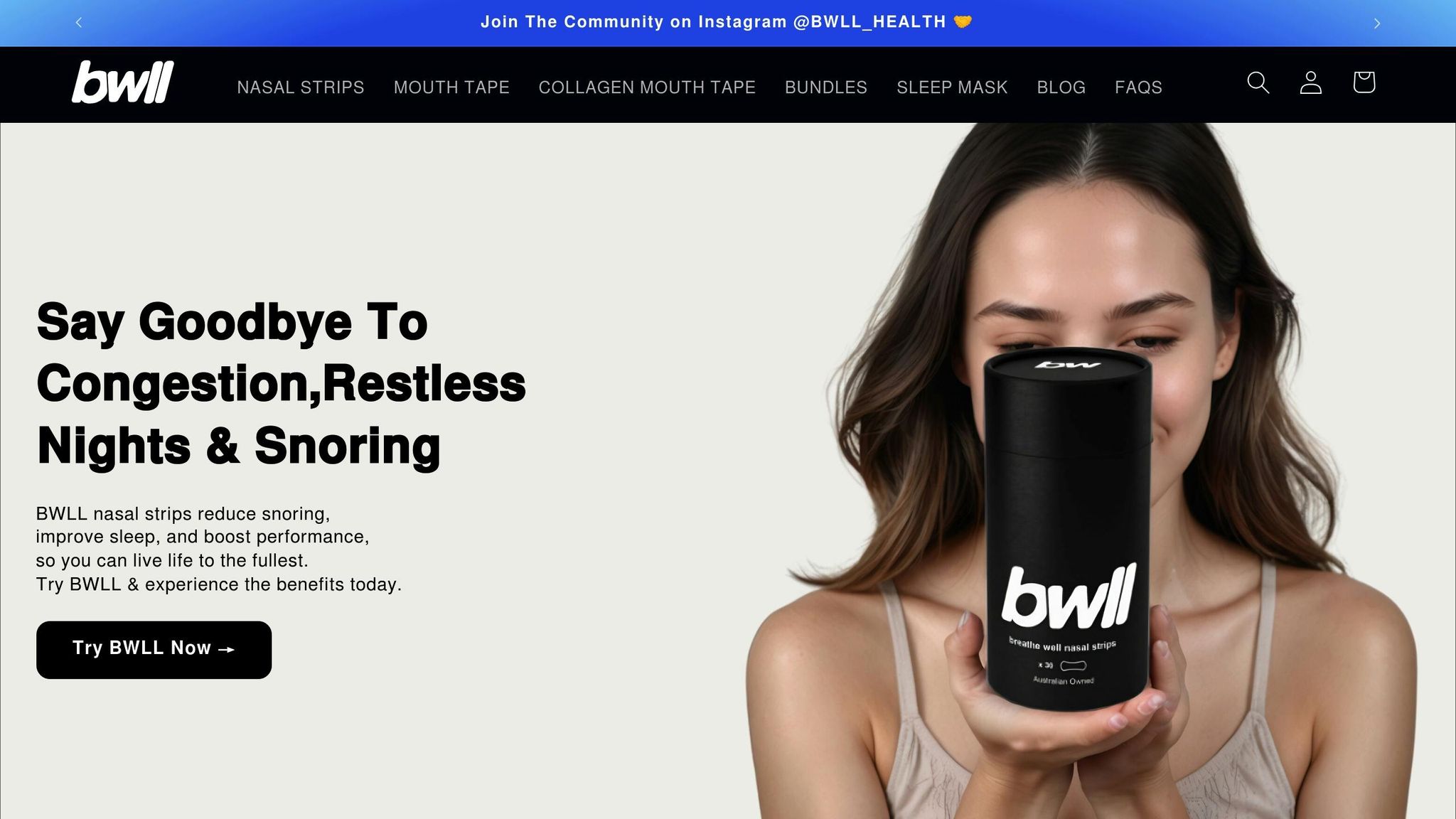
Nasal Strips for Recovery: Do They Work?
Share
Nasal strips are a simple, drug-free way to improve breathing, which can help with recovery and sleep. By gently lifting the nasal passages, these strips reduce airway resistance, making it easier to breathe - especially during sleep when the body focuses on repair and recovery. They are particularly useful for athletes or anyone dealing with nasal congestion, helping to improve oxygen intake and support restorative sleep.
Key points:
- Nasal strips widen nasal airways, reducing airflow resistance by around 9%.
- Better airflow leads to improved oxygen intake, aiding muscle repair and energy restoration.
- They can reduce snoring and improve sleep quality, essential for physical and mental recovery.
- BWLL Nasal Strips, a popular option, offer up to 18 hours of use with hypoallergenic adhesive.
While studies show mixed results for their impact on exercise recovery, many users report better breathing and sleep quality. For $36.00 (30-pack), they’re an affordable, safe option to try for better recovery.
Testing Intake Breathing Strips: 15 Days Later
How Nasal Strips Help Recovery
Efficient breathing plays a key role in recovery, and nasal strips offer a simple yet effective way to support this. By gently lifting your nasal passages, these strips make breathing easier, which can significantly aid your body's recovery processes.
How Nasal Strips Work
Nasal strips are designed with flexible bands that gently lift and open your nasal passages at the nasal valve. Think of them as a tiny external brace for your nose. Once applied, the adhesive keeps the strip securely in place while the bands create a consistent, gentle pressure that widens your nostrils. The best part? This is an entirely external solution - no drugs, no invasive devices, and it starts working immediately.
A great example is BWLL Nasal Strips, which can stay in place for up to 18 hours. This makes them ideal for overnight use, a time when your body does some of its most critical recovery work. The hypoallergenic adhesive is gentle on sensitive skin, and since the strips are drug-free, you can use them nightly without worrying about side effects or dependency.
Benefits for Breathing and Oxygen Uptake
By reducing resistance in your airways, nasal strips help improve oxygen flow and make breathing less of a chore. During recovery - whether after exercise or simply during sleep - your body relies on oxygen to repair muscles, restore energy, and even consolidate memories. If nasal congestion or narrow airways force you to work harder for each breath, it can divert energy away from these essential recovery processes.
Nasal strips change the game by making breathing more natural and efficient. With better oxygen intake, your cardiovascular system doesn’t have to work overtime to deliver oxygen to your muscles and tissues. This is especially helpful for athletes or anyone recovering from physical exertion, as oxygen is critical for repairing muscle damage and building strength.
Impact on Sleep and Recovery
Better breathing doesn’t just help physically - it also transforms your sleep. Improved airflow through your nose leads to better sleep quality, which is essential for recovery. When you can maintain nasal breathing throughout the night, your body enters deeper sleep phases more easily, allowing for optimal overnight repair.
Nasal breathing during sleep helps regulate your nervous system and reduces disruptions like snoring. And while snoring might seem like just a noisy inconvenience, it often signals restricted airflow. Nasal strips help keep airways open, reducing snoring and minimising the micro-awakenings that can interrupt your sleep and slow down recovery.
Overnight is when your body releases growth hormones, repairs tissues, and processes both physical and mental stress from the day. BWLL Nasal Strips ensure that you’re breathing freely during these critical hours, giving your body the chance to fully focus on healing. From the first night of use, you can experience relief from nasal congestion and enjoy the benefits of smoother, uninterrupted breathing.
For those who exercise regularly or lead physically demanding lives, this combination of better oxygen uptake and improved sleep quality creates a powerful edge in recovery. Your body gets the oxygen it needs and the restful sleep required to use that oxygen effectively.
Because nasal strips are drug-free, they don’t interfere with your body’s natural sleep chemistry or recovery hormones. Instead, they simply enhance the foundation of recovery - your ability to breathe effortlessly and consistently.
Do Nasal Strips Actually Work?
Scientific studies present mixed findings about nasal strips. For instance, one study examining their role in anaerobic exercise recovery found no noticeable impact on heart rate or minute ventilation. While nasal strips might enhance airflow, their effect on immediate post-exercise recovery remains unclear. More research is required to fully understand their potential benefits in this area.
Up next, we’ll dive into user experiences and other factors that could affect how effective nasal strips are.
sbb-itb-dc10090
How to Use Nasal Strips
Get the most out of your nasal strips by following these simple steps for proper use.
Tips for Best Results
Start with clean, dry skin. Wash your nose with a mild soap to remove any oils, dirt, or moisture, and then pat it completely dry. This is key because adhesive won’t stick well to skin that’s wet, oily, or moisturised. Taking the time to prepare your skin properly makes all the difference.
Positioning matters. Place the strip across the bridge of your nose, making sure it’s centred just above your nostrils. This helps gently lift and open your nasal passages. For the best results, aim for symmetry and avoid stretching the strip as you apply it.
When applying the strip, carefully peel it off the liner without touching the adhesive. Press it firmly onto your nose, smoothing out any bumps or air bubbles to ensure it stays in place.
Choosing the right size is just as important. BWLL Nasal Strips come in various sizes, so pick one that matches your nose width. A strip that's too small won’t provide enough lift, while one that's too large might not stick properly or could feel uncomfortable.
When it’s time to remove the strip, be gentle. Wash your face with warm water for at least 10 seconds to loosen the adhesive. Then, slowly lift each side and peel it off carefully. Doing this in the shower can make removal even easier.
Are Nasal Strips Worth It for Recovery?
Nasal strips can be a game-changer for recovery by making breathing easier, improving oxygen intake, and helping you get better sleep. As a drug-free option, they provide quick relief and are safe to use every night. Here’s why they stand out when it comes to aiding recovery.
Key Benefits
- Better Oxygen Flow: Nasal strips open up your nasal passages, helping you breathe more efficiently during sleep. Many users say this leads to better recovery, especially after physical activity.
- Relief for Congestion: Whether it’s allergies or a cold, nasal strips can ease congestion, making them a go-to for anyone dealing with blocked airways. Active individuals often find them handy for post-workout recovery.
- Non-Invasive and Safe: Designed to be medication-free, nasal strips can be used daily without worries about side effects. They’re even safe for pregnant users.
- Immediate Results: Just apply a strip before bed, and you’ll notice improved breathing right away - no waiting, no hassle.
Why Choose BWLL Nasal Strips?

BWLL Nasal Strips are a step above the rest, combining comfort, performance, and sustainability. Made with hypoallergenic materials, they’re gentle on the skin while offering a snug, secure fit. Thanks to their strong adhesive, they stay in place for up to 18 hours, even if you’re a restless sleeper.
What’s more, they’re affordable and environmentally friendly. A 30-pack costs A$36.00, and bundle deals with free shipping and bonus packs make them even more budget-friendly. Plus, BWLL uses eco-conscious packaging crafted from recycled and biodegradable materials.
Whether you’re an athlete or just someone seeking better sleep, BWLL Nasal Strips offer a simple, effective way to support recovery. They’re easy to integrate into your nightly routine and deliver results you can feel immediately.
FAQs
Are nasal strips effective and safe for improving breathing?
Nasal strips offer a straightforward, drug-free way to improve airflow by gently opening up the nostrils. They’re often used to ease nasal congestion, reduce snoring, and make breathing more comfortable overall. For most people, they’re safe to use daily, though some might experience minor skin irritation.
Unlike other breathing aids, nasal strips are non-invasive, simple to apply, and work well for mild to moderate breathing challenges. While they’re not a solution for more serious conditions like sleep apnoea, they can be a dependable choice for enhancing nasal airflow and supporting a better night’s sleep.
Can I use nasal strips with other treatments for nasal congestion, like medications or humidifiers?
Yes, nasal strips can be used alongside other remedies for nasal congestion, such as medications or humidifiers. Since they are drug-free and non-invasive, they’re safe to pair with nasal sprays, decongestants, or even a humidifier to help improve airflow and make breathing more comfortable.
This combination can be especially helpful if you’re dealing with nighttime congestion or trying to improve your sleep. Just be sure to follow the directions for any other treatments you’re using, and if you’re uncertain, it’s always a good idea to check with a healthcare professional.
What can I do if nasal strips cause skin irritation?
If nasal strips are causing skin irritation, it’s a good idea to stop using them for a while to let your skin recover. You can ease the discomfort by applying a gentle, hypoallergenic moisturiser or aloe vera gel to the irritated area. Switching to hypoallergenic nasal strips in the future might help lower the chances of irritation.
However, if the irritation persists or worsens, it’s best to stop using the strips altogether and seek advice from a healthcare professional. Your comfort and skin health should always come first when using nasal strips.